Betelgeuse is a red supergiant star, being the ninth brightest object in the night sky. It is located in the Orion constellation, where it holds the second place, as the brightest star.
Key Facts & Summary
- Betelgeuse is a variable star, with an apparent magnitude varying between +0.0 and +1.13.
- Betelgeuse is a red supergiant of spectral type M1-2, it has the widest range of varying magnitude out of any first-magnitude star.
- It can be seen with the naked eye and its mass has been estimated to be around 10 – 20 +, that of our Sun. It is one of the biggest stars that can be seen in the night sky with an unaided eye.
- If Betelgeuse were to replace or Sun, its surface would extend beyond the asteroid belt, thus engulfing the orbits of Mercury, Venus, Earth, Mars, and possibly Jupiter as well.
- Because of its enormous mass, Betelgeuse has evolved rapidly. Its age is quite young, estimated to be around 10 million years old.
- Betelgeuse is about 640 light-years away from Earth.
- It is the first star to have its angular size of the photosphere measured. It happened in 1920.
- The star has been observed to move through the interstellar medium at a speed of 30 km / 18.6 mi per hour.
- Its radius is about 887 to 955 times that of the Sun.
- Betelgeuse is losing about 1 solar mass every 10.000 years. It is surrounded by an intricate envelope – nebulae- about 250 times the star’s size that formed due to its lost mass. The dust and gas extend up to 20.000 AU away from Betelgeuse.
- Betelgeuse is one of the three stars that make up the Winter Triangle asterism (The other two stars are Procyon, Canis Minor), and it marks the center of the Winter Hexagon. Thus Betelgeuse is part of two familiar winter asterisms.
- Betelgeuse is sometimes often known as Alpha Orionis.
Since it is so bright in the night sky, many ancient cultures knew about Betelgeuse. Its name is of Arabic origin, meaning “the armpit of Orion”. It has been named after its particular location in the Orion constellation. However, the first person to study and note its varying brightness was Sir John Herschel, in 1836. It was since conducted that the star brightens and then fades for a period of 400 days.
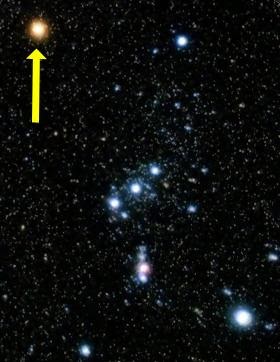
Later, in 1920 a trio formed of Albert Michelson, Francis Pease, and John Anderson used interferometry and a large telescope to gather more data about the star but their results lacked certain accuracies.
With the advancement of astronomical technology it was calculated that the star had shrunk by about 15% since 1993, but without a significant diminution in magnitude.
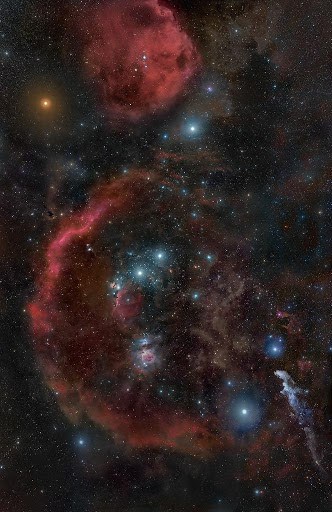
Formation
It is believed that Betelgeuse evolved from an O-type main-sequence star. Betelgeuse is a red supergiant, meaning it is an aging star that has consumed most of its core’s supply of hydrogen and fuel. It is theorized that Betelgeuse formed about 10 million years ago, out of dust, gas and gravitational pull. It managed to form especially due to the molecular clouds present in Orion. Betelgeuse has quite a young age, for a star. It is expected that it will explode as a supernova. Most calculations suggest that this will happen anytime in the next million years.
Distance, Size, and Mass
Betelgeuse is around 640 light-years away from Earth, located in the Orion constellation. It is one of the biggest stars discovered and the only one of its size that can be visible from Earth with the naked eye.
Because of its pulsating nature, it is difficult to accurately pinpoint many details regarding it. However, estimates suggest that Betelgeuse has a diameter of about 850 miles / 1.4 billion km.
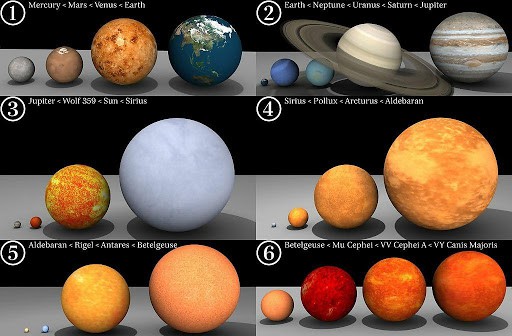
Its radius is about 1.000 times that of our Sun, and if Betelgeuse would be placed in our solar system, the star would reach beyond the orbit of Jupiter.
Betelgeuse’s mass has been calculated to be between 10 to 20 times that of our Sun, maybe even more.
Characteristics
Betelgeuse has become smaller since 1993. The star is constantly losing mass, about 1 solar mass every 10.000 years. This lost mass is engulfing the star, forming a sort of nebula about 250 times bigger than Betelgeuse. Some parts of the mass have been blown off into space by powerful solar winds, and reach up to more than 30.000 AU away from Betelgeuse.
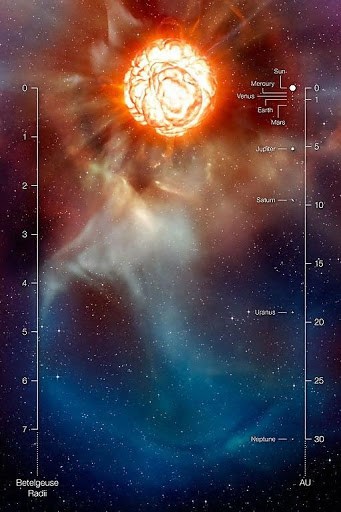
Because of its mass, it is believed that Betelgeuse has an overall density smaller than air. The surface temperature is estimated to be around 3.200 C / 5.800 F, about 60% as hot as the Sun. Betelgeuse’s luminosity is about 100.000 greater than our Sun, and because of this extreme luminosity, it is predicted that Betelgeuse will explode as a supernova.
If its mass is indeed lower than 15 solar masses, it is possible that Betelgeuse will become one of the exceedingly rare neon-oxygen white dwarfs. Until its pulsating nature can be more thoroughly examined, leading to more accurate estimations, its fate remains speculative. Betelgeuse’s rotation period is believed to take around 15 – 30 years. The star travels at supersonic speeds: 30 km / 18.6 mi per hour. Its stellar wind creates a bow shock. The stellar wind ejects vast amounts of gas into the interstellar medium at a speed of 17 km / 4.3 mi per hour, thus heating the material surrounding the star.
Star System
There were some objects detected around Betelgeuse, but have never been observed more than one time. It is possible that Betelgeuse could have other stars or other objects around it. Observations continue.
Location
Betelgeuse is located in the Orion constellation, being the second-brightest star and marking one of Orion’s “shoulders”. The other shoulder is marked by the bright giant Bellatrix, Gamma Orionis.
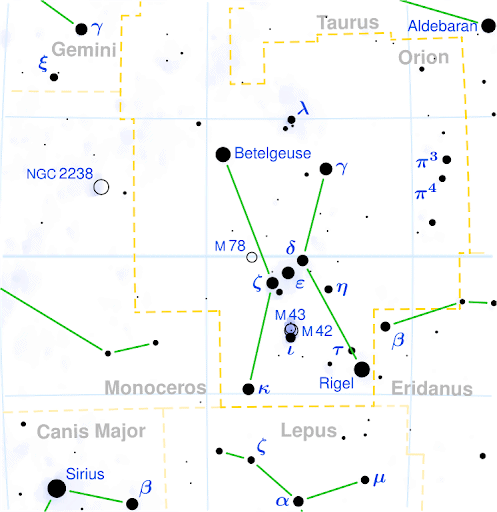
Because Betelgeuse is so big and bright, and because it is a variable star, it can sometimes outshine the constellations brightest star, Rigel – Beta Orionis.
The Future
Betelgeuse will explode as a supernova in the far future. When this will happen, large bursts of gamma radiation will spread across and the star will be as bright as the Moon in the night sky for several weeks. It may even be visible during the day.
What will happen to Betelgeuse after that is uncertain if its mass is indeed above 15 times that of our Sun, it will either become a black hole or a neutron star. If its mass is lower than 15 solar masses than Betelgeuse might become one of the exceedingly rare neon-oxygen white dwarfs. As technology progresses, more accurate calculations could be made and thus predictions.
Did you know?
- Betelgeuse can be seen at the beginning of January rising in the east just after sunset.
- It is visible throughout the globe with the exception of Antarctica, by mid-September to mid-March, and best viewed in mid-December.
- Since it is a pulsating star, it will eventually surpass Rigel and become the sixth brightest star in the night sky. It will even occasionally be brighter than Capella.
- At its faintest, Betelgeuse can fall behind Deneb and even Beta Crucis, thus gaining the title of the 20th brightest star.
- Only 13% of Betlegeuse’s radiant energy is emitted in the form of visible light.
- In Sanskrit, Betelgeuse was known as Bahu – “running antelope or stag” – referring to the constellation as a whole.
- The ancient samurai clans Taira - Heike from Japan, adopted Betelgeuse and its red color as their symbol.
- In the lore of the Tahitian people, Betelgeuse was one of the pillars propping up the sky, known as “Anâ-varu”, the pillar to sit by.
- The aboriginal people of Australia may have known before astronomers that Betelgeuse was a variable star. This is evidenced through one of their mythological stories regarding the star.
Sources:
Image source:
- https://nightsky.jpl.nasa.gov/images/news/OrionBetelLoc.jpg
- https://upload.wikimedia.org/wikipedia/commons/thumb/4/47/Orion_Head_to_Toe.jpg/664px-Orion_Head_to_Toe.jpg
- https://upload.wikimedia.org/wikipedia/commons/thumb/c/cc/Star-sizes.jpg/1024px-Star-sizes.jpg
- https://upload.wikimedia.org/wikipedia/commons/thumb/8/81/Betelgeuse_Plume_eso0927d.jpg/511px-Betelgeuse_Plume_eso0927d.jpg
- https://upload.wikimedia.org/wikipedia/commons/thumb/b/bf/Orion_constellation_map.svg/745px-Orion_constellation_map.svg.png
